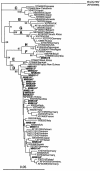High prevalence of antibodies to hepatitis A and E viruses and viremia of hepatitis B, C, and D viruses among apparently healthy populations in Mongolia
- PMID: 15013993
- PMCID: PMC371212
- DOI: 10.1128/cdli.11.2.392-398.2004
High prevalence of antibodies to hepatitis A and E viruses and viremia of hepatitis B, C, and D viruses among apparently healthy populations in Mongolia
Abstract
The prevalence of infection with hepatitis A virus (HAV), HBV, HCV, HDV, and HEV was evaluated in 249 apparently healthy individuals, including 122 inhabitants in Ulaanbaatar, the capital city of Mongolia, and 127 age- and sex-matched members of nomadic tribes who lived around the capital city. Overall, hepatitis B surface antigen (HBsAg) was detected in 24 subjects (10%), of whom 22 (92%) had detectable HBV DNA. Surprisingly, HDV RNA was detectable in 20 (83%) of the 24 HBsAg-positive subjects. HCV-associated antibodies were detected in 41 (16%) and HCV RNA was detected in 36 (14%) subjects, none of whom was coinfected with HBV, indicating that HBV/HCV carriers account for one-fourth of this population. Antibodies to HAV and HEV were detected in 249 (100%) and 28 (11%) subjects, respectively. Of 22 HBV DNA-positive subjects, genotype D was detected in 21 subjects and genotype F was detected in 1 subject. All 20 HDV isolates recovered from HDV RNA-positive subjects segregated into genotype I, but these differed by 2.1 to 11.4% from each other in the 522- to 526-nucleotide sequence. Of 36 HCV RNA-positive samples, 35 (97%) were genotype 1b and 1 was genotype 2a. Reflecting an extremely high prevalence of hepatitis virus infections, there were no appreciable differences in the prevalence of hepatitis virus markers between the two studied populations with distinct living place and lifestyle. A nationwide epidemiological survey of hepatitis viruses should be conducted in an effort to prevent de novo infection with hepatitis viruses in Mongolia.
Figures


References
-
- Aikawa, T., M. Kojima, M. Takahashi, T. Nishizawa, and H. Okamoto. 2002. Identification of indigenous hepatitis E virus from a Japanese patient who contracted sporadic acute hepatitis in 1982. J. Infect. Dis. 186:1535-1536. - PubMed
-
- Alestig, E., C. Hannoun, P. Horal, and M. Lindh. 2001. Hepatitis B virus genotypes in Mongols and Australian aborigines. Arch. Virol. 146:2321-2329. - PubMed
-
- Arauz-Ruiz, P., H. Norder, B. H. Robertson, and L. O. Magnius. 2002. Genotype H: a new Amerindian genotype of hepatitis B virus revealed in Central America. J. Gen. Virol. 83:2059-2073. - PubMed
-
- Blum, H. E., S. Wieland, E. Walter, F. von Weizsacker, W.-B. Offensperger, and D. Moradpour. 1998. Natural course of HBV infection, p. 75-92. In R. Koshy and W. H. Caselmann (ed.), Hepatitis B virus. Molecular mechanisms in disease and novel strategies for therapy. Imperial College Press, London, United Kingdom.
-
- Edstam, J. S., N. Dulmaa, P. Nymadawa, A. Rinchin, J. Khulan, and A. M. Kimball. 2002. Comparison of hepatitis B vaccine coverage and effectiveness among urban and rural Mongolian 2-year-olds. Prev. Med. 34:207-214. - PubMed
Publication types
MeSH terms
Substances
LinkOut - more resources
Full Text Sources
Medical

